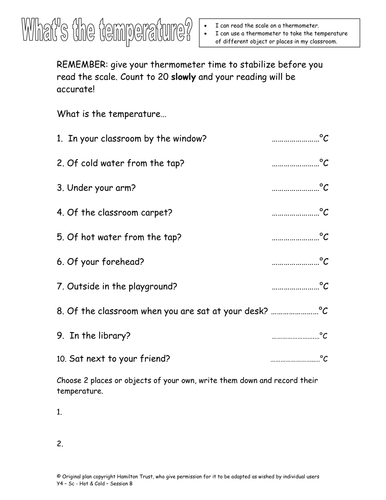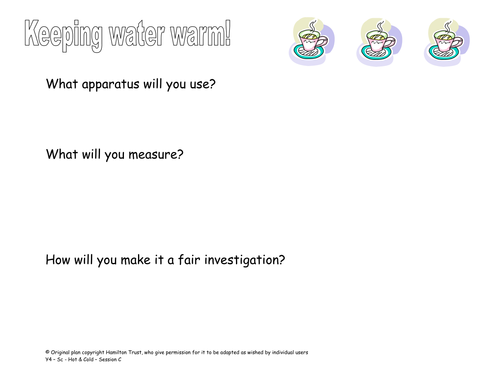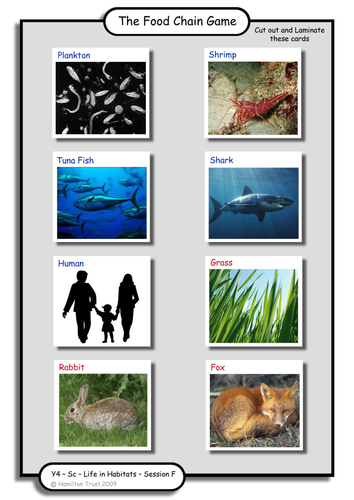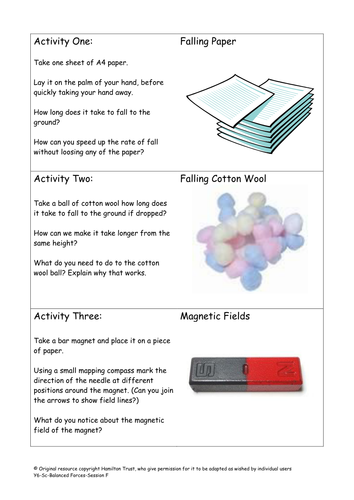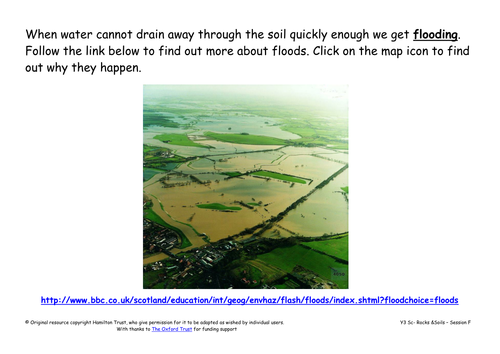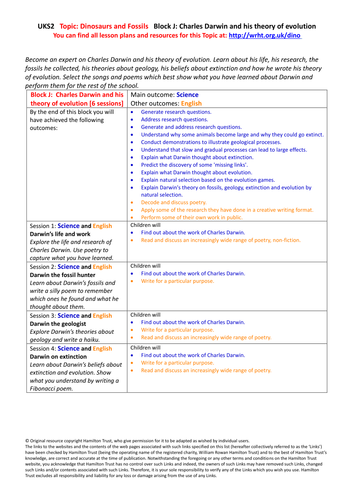
3k+Uploads
10010k+Views
11618k+Downloads
Primary science

Life and where it lives
Use KWL grids to find out what children already know about living organisms and habitats. Discuss MR GRENS – the seven characteristics of living organisms. Children sort things into alive, once alive and never have lived categories. Begin looking at different habitats.
Suitable for Year 4 pupils.
Find other lesson plans and resources at www.hamilton-trust.org.uk.

Using a thermometer
Look at a line graph of temperature changes in the classroom over 24hrs and explain why it goes up and down. Establish how to use a thermometer accurately and safely, including a close look at different scales. Look at a range of temperatures of different places or objects.
Suitable for Year 4 pupils.
Find other lesson plans and resources at www.hamilton-trust.org.uk.

Keeping hot!
A hot flask of tea introduces the concept of thermal insulation leading to a discussion of how we and other animals keep warm or cool. Children plan and carry out an investigation on keeping water warm. Which wrapping is the best insulator?
Suitable for Year 4 pupils.
Find other lesson plans and resources at www.hamilton-trust.org.uk.

Dinner time!
Children explore the feeding relationship (food chains) between organisms living in a particular habitat. (Re)introduce the words producer, consumer, predator and prey. Children build food chains online and play a Food Chain Game. Look back at KWL grids from Session A.
Suitable for Y4 pupils.
Find other lesson plans and resources at www.hamilton-trust.org.uk.

Elastic band investigation
S – t – r – e – t – c – h is the key word in this session as elastic bands are safely tested in the classroom. What happens as the mass suspended from the elastic band increases? Data on graphs will make the outcome clear.
Suitable for Year 6 pupils.

Fantastic Forces!
Fantastic Forces fun in this session! Children work through 6 short activities which reinforce concepts linked to forces. Which magnet is the most powerful? What does a magnetic field look like? These questions and more are answered.
Suitable for Year 6 pupils.
Find other lesson plans and resources at www.hamilton-trust.org.uk.

Soil investigation
Look at images, and discuss the effects and causes of flooding. Do a practical investigation about the permeability of 3 different types of soils including measuring. Review what children have learnt.
Suitable for Y3 pupils.

Floating and sinking
Explore which materials float and which sink. Children predict by sorting and testing, then record what has been found out in different ways. Use topic books and do some floating and sinking activities online.
Suitable for Year 1 pupils.
Find other lesson plans and resources at www.hamilton-trust.org.uk.

Other drugs
Discuss the use of the word drug for medicinal purposes as well as addictive substances. Children draw posters warning about the dangers of drugs in the home and draw conclusions about the various ongoing investigations about micro-organisms.
Suitable for Y6 pupils.

Dinosaurs and Fossils - Dinosaur Species - Upper Key Stage 2
Become an enthusiastic, expert palaeontologist!
Learn about the species of the Mesozoic Era with very practical and engaging activities. Reconstruct a dinosaur by adding clay to a dinosaur skeleton, make a Dino-family jigsaw, take part in an animal survival game, make a 3D Mesozoic timeline showing the three main eras and populate each section with pictures of the correct dinosaur species.
- Lesson 01: Flesh it out!
Learn about how palaeoartists reconstruct dinosaurs from fossils and try it yourself!
- Lesson 02: Dino families
Learn about the main family groups of dinosaurs and make a Dino-family jigsaw.
- Lesson 03: The survival game
Investigate dinosaurs and their environments, understand how they would have competed for resources and take part in an animal survival game.
- Lesson 04: 3D Mesozoic Timeline Part 1
Find out about the three main periods of the Mesozoic Era and portray their landscapes and vegetation in a 3D model.
- Lesson 05: 3D Mesozoic Timeline Part 2
Populate your model of the Mesozoic Era with pictures of the correct dinosaur species living in each of the three periods.
Find more lesson plans and resources at www. hamilton-trust.org.uk.

Dinosaurs and Fossils - Mary Anning - Upper Key Stage 2
Be a palaeontologist! Excavate a fossil block and research the three main epochs of fossils. Find out how fossils are made and make your own. Tour your school sharing your knowledge with other children.
Includes:
- Topic Overview
- Block Overview
- Lesson 01: Fossils in the UK
Re-cap how fossils are made, learn about the fossil-hunting areas of the UK and create a map.
- Lesson 02: History of science
Learn about the 18th Century science, society and the status of women.
- Lesson 03: Mary Anning
Learn about Mary Anning, her life as a fossil hunter and her achievements.
- Lesson 04: Improvise a play
Improvise a play to tell other children about Mary Anning, drawing on all your previous research.
Find more lesson plans and resources at www. hamilton-trust.org.uk.

Dinosaurs and Fossils - Fossils and Rocks - Upper Key Stage 2
Be a palaeontologist! Excavate a fossil block and research the three main epochs of fossils. Find out how fossils are made and make your own. Tour your school sharing your knowledge with other children.
Includes:
- Topic Overview
- Block Overview
- Lesson 01: Being palaeontologists
Try your hand at being a palaeontologist by excavating a fossil block, generating questions about fossils and starting a dino-dictionary.
- Lesson 02: Fossils and the Timeline
Develop your palaeontologist expertise; research the three main epochs of fossils and put them on a timeline.
- Lesson 03: How are fossils formed?
Find out how fossils were made and make your own clay mould fossil, an ‘amber’ resin fossil and your own Dino-poo fossil.
- Lesson 04: Visit to a Natural History Museum
Experience fossils at first hand in a Natural History Museum; study them in detail and make drawings.
- Lesson 05: Palaeontologists on tour
Share your palaeontologist expertise with other children by taking your learning on tour.
Find more lesson plans and resources at www. hamilton-trust.org.uk.

Dinosaurs and Fossils - Charles Darwin and his theory of evolution - Upper Key Stage 2
Be a palaeontologist! Become an expert on Charles Darwin and his theory of evolution. Learn about his life, his research, the fossils he collected, his theories about geology, his beliefs about extinction and how he wrote his theory of evolution. Select the songs and poems which best show what you have learned about Darwin and perform them for the rest of the school.
Includes:
- Topic Overview
- Block Overview
- Lesson 01: Darwin's life and work
Explore the life and research of Charles Darwin. Use poetry to capture what you have learned.
- Lesson 02: Darwin the fossil hunter
Learn about Darwin’s fossils and write a silly poem to remember which ones he found and what he thought about them.
- Lesson 03: Darwin the geologist
Explore Darwin’s theories about geology and write a haiku.
- Lesson 04: Darwin on extinction
Learn about Darwin’s beliefs about extinction and evolution. Show what you understand by writing a Fibonacci poem.
- Lesson 05: Darwin and evolution
Explore how Darwin came up with his theory of evolution by natural selection and write a Horrible Histories style song.
- Lesson 06: Evolution performance
Select the songs and poems that best show what you have learned about Darwin. Practise and then perform them for the rest of the school.
Find more lesson plans and resources at www. hamilton-trust.org.uk.

Dinosaurs and Fossils - Dinosaur Behaviour - Upper Key Stage 2
Become an enthusiastic, expert palaeontologist!
Learn about the importance of dinosaur egg fossils and what they tell us about dinosaurs; research the behaviour of dinosaurs in family groups; then try your hand at film making and create a short dinosaur film about an aspect of dinosaur behaviour.
Includes:
- Topic Overview
- Block Overview
- Lesson 01: Dinosaur egg
Learn about dinosaur egg fossils and how useful they are to palaeontologists.
- Lesson 02: Dinosaur families
Research the behaviour of dinosaurs in their family groups and make your finger puppet dinosaurs ready to film.
- Lesson 03: Dinosaur filming
Create an accurate film backdrop for your short film about an aspect of dinosaur behaviour.
- Lesson 04: Classroom cinema!
Compose a factual voice-over for your dinosaur movie, edit and embed into PowerPoint.
Find more lesson plans and resources at www. hamilton-trust.org.uk.

Dinosaurs and Fossils - Fossil Humans - Upper Key Stage 2
Become an enthusiastic, expert palaeontologist!
Learn about the fascinating story of human evolution. Create your own family tree and relate it to the family tree of the human species. Find out about how the early humans dispersed around the world. Use storytelling to pass on your learning about human evolution to other children.
Includes:
- Topic Overview
- Block Overview
- Lesson 01: The human family tree
Children learn about and create their own family tree of human evolution.
- Lesson 02: The human journey
Make a map showing early human dispersal around the world.
- Lesson 03: Human fossils
Learn about four key human fossils and put them on a timeline.
- Lesson 04: Meeting Neanderthals
Take part in a philosophical enquiry about Homo sapiens meeting Neanderthals.
- Lesson 05: The human story
Share your learning about human evolution through storytelling.
Find more lesson plans and resources at www. hamilton-trust.org.uk.

Dinosaurs and Fossils - Dinosaur DIY - Upper Key Stage 2
Be a palaeontologist! Research key features of dinosaurs and how they are adapted to their environment; design your own dinosaur perfectly adapted to either the Triassic, Jurassic or Cretaceous period; create the structure, cover and paint your dinosaur model; finally, contribute to an ‘I Spy Dinosaurs’ class book and share your knowledge with other children.
Includes:
- Topic Overview
- Block Overview
- Lesson 01: Dino DIY - planning
Research key features of dinosaurs and then design a dinosaur perfectly adapted to either the Triassic, Jurassic or Cretaceous period.
- Lesson 02: Dino DIY - making
Working from a design plan, create the structure of your dinosaur.
- Lesson 03: Dino DIY - painting
Research skin colours and textures of modern living things and apply your knowledge to create the most suitable surface for your dinosaur model.
- Lesson 04: 'I spy' a DIY Dino
Contribute to a class ‘ I Spy’ dinosaur book with photographs, list of characteristics and possible ‘footprints’.
Find more lesson plans and resources at www. hamilton-trust.org.uk.

Dinosaurs and Fossils - Ice Age Fossils - Upper Key Stage 2
Become an enthusiastic, expert palaeontologist! Study a distinctive Victorian silhouette showing palaeontologist William Buckland, his family and his fossils. Learn about his discoveries and links to Mary Anning. Research the Ice Ages and Ice Age animals in Britain. Exhibit work and invite visitors to share in your learning.
Includes:
- Topic Overview
- Block Overview
- Lesson 01: The Buckland Silhouette
Learn about William Buckland the famous palaeontologist, his family life and his fossil hunting.
- Lesson 02: The first dinosaur
Find out more about Buckland, his discovery of the first named dinosaur, the Megalosaurus, his other discoveries and his links to Mary Anning.
- Lesson 03: The Ice Age
Make a timeline showing the Ice Ages and the Ice Age animals in Britain.
- Lesson 04: Making fossils
Make replica dinosaur and Ice Age fossils and experimental silhouettes.
- Lesson 05: Experimenting with silhouettes
Try out three different ways of making silhouettes: casting shadows, using sun-printing and using a shadow theatre.
- Lesson 06: Making a silhouette
Choose one method of making a silhouette, inspired by the Buckland picture, and record it using a camera or as a piece of art.
- Lesson 07: Sharing the silhouettes
Label their silhouettes and plan an informative talk; then decide on a design for an exhibition and invite people to enjoy their work.
Find more lesson plans and resources at www. hamilton-trust.org.uk.

Dinosaurs and Fossils - Dinosaur Extinction - Upper Key Stage 2
Become an enthusiastic, expert palaeontologist!
Learn about the climate, vegetation and living things of the late Cretaceous period. Research the main dinosaur extinction theories; plan and argue the case for each theory in a class debate. Finally compose a soundtrack for life after the extinction event, ready to play to guests in a darkened, atmospheric space.
Includes:
- Topic Overview
- Block Overview
- Lesson 01: End of an era
After researching the timeline of the end of the Mesozoic Era, gain an understanding of the climate, vegetation and living things of the late Cretaceous period.
- Lesson 02: Delving deeper
Research the variety of extinction theories and consider arguments for and against each theory.
- Lesson 03: Dino debate
Plan and argue the case for each extinction theory in a class debate before voting for the most plausible.
- Lesson 04: Extinction Music in the dark
After reviewing the different extinction theories, compose a class soundtrack for life after the extinction event. Play to guests in a darkened, atmospheric space.
Find more lesson plans and resources at www. hamilton-trust.org.uk.


